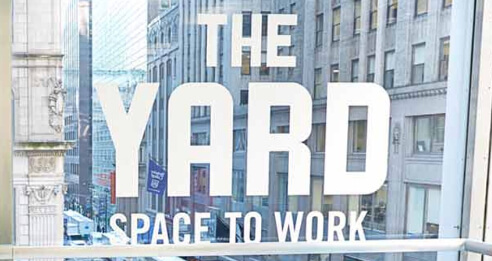
Largest Coworking Companies


As we stand at the intersection of technology, flexible work models, and community-driven spaces, the anticipation for trends shaping 2024 becomes a crucial compass for coworking spaces navigating the dynamic currents of the industry.
The current coworking scene is like a mix of different professionals looking for flexible, collaborative, and inspiring places to work. Coworking spaces have transformed into more than just shared offices; they are vibrant ecosystems fostering creativity, networking, and productivity.
With the surge in remote work and changing work dynamics, the demand for dynamic coworking solutions is at an all-time high.
The tools and software that power coworking spaces are the backbone of member experiences, operational efficiency, and overall success. The race to provide cutting-edge resources is not merely a sprint; it's a marathon towards creating workspaces that anticipate and cater to the evolving needs of a diverse workforce.
As we gaze into the near future, the anticipation of trends set to dominate 2024 brings excitement and possibilities. These anticipated shifts underscore the industry's commitment to innovation, adaptability, and the creation of spaces that transcend conventional work environments.
Join us on a journey to explore the trends that will define the coworking landscape in 2024. From fostering sustainability to embracing cutting-edge technologies, ensuring that coworking spaces remain not just functional but also dynamic, inspiring, and future-ready.
Coworking spaces are embracing data-driven insights to enhance member experiences and operational efficiency. By analyzing member behavior and preferences, operators gain valuable insights, going beyond traditional metrics to uncover hidden patterns.
In 2024, a focus on predictive analytics will shape resource allocation, ensuring proactive adjustments to meet evolving member needs. This approach optimizes desk and meeting room availability, creating personalized experiences that cater to individual preferences.
The goal is to curate a workspace that fosters productivity, collaboration, and a sense of belonging, without diving into complex machine learning techniques. The key is understanding data and turning insights into an exceptional coworking experience.
A fascinating trend is taking center stage – the hyper-specialization of spaces. This shift marks a departure from the one-size-fits-all approach, as work environments now strive to cater to specific niches, providing tailor-made solutions for various professional needs.
Traditionally, coworking spaces aimed for a broad appeal, accommodating a wide range of professionals. However, the current trend leans towards spaces that are specifically designed to meet the unique requirements of certain industries or professional groups.
From tech-centric hubs to creative studios, these niche-specific environments foster a sense of community and collaboration among individuals with shared interests and goals.
One example of a company that niched down is Tech Innovators Hub. This specialized coworking space caters exclusively to technology enthusiasts, startups, and industry experts.
It provides state-of-the-art facilities, fostering an atmosphere conducive to cutting-edge ideas, collaborations, and the rapid exchange of knowledge.
The hyper-specialization of coworking spaces represents a paradigm shift towards more personalized and industry-specific work environments. This trend not only caters to the diverse needs of professionals but also fosters a sense of community and collaboration among like-minded individuals. As we embrace this new era of niched-down workspaces, the future of work is set to be more dynamic, specialized, and enriched with opportunities for innovation and connection.

Sustainability isn't just a buzzword; it's a commitment to creating coworking environments that prioritize the well-being of both professionals and the planet. In 2024, as coworking spaces evolve, sustainable practices take center stage, with a profound impact on the software that powers these shared workspaces.
In the quest for sustainability, coworking spaces are embracing green design principles that harmonize functionality with environmental consciousness. From energy-efficient lighting to upcycled furniture, these spaces are redefining the conventional office environment. In 2024, anticipate a surge in coworking spaces incorporating biophilic design, integrating nature-inspired elements for a healthier and more inspiring workspace.
Expect a shift towards sustainability-focused resource management software designed to optimize energy consumption, reduce waste, and streamline eco-friendly practices. Coworking platforms will integrate features that allow spaces to track and minimize their carbon footprint, empowering both operators and members to make environmentally conscious choices.
Sustainability extends beyond physical spaces and software—it's about fostering a culture of environmental responsibility within coworking communities. Embrace the green revolution in coworking—where sustainable practices, innovative software, and a shared commitment to the planet converge, creating workspaces that not only support professional growth but also contribute to a healthier, more sustainable future for all.
The evolution of hybrid work models takes center stage, reshaping how employees interact with coworking spaces. The traditional boundaries between remote and in-office work are fading away, giving rise to a more flexible approach that aligns with the diverse work preferences of modern professionals.
Flexibility is key in this evolving work environment, with coworking spaces leading the way. In 2024, employees desire the freedom to choose where and how they work. Coworking spaces go beyond being just physical locations; they become flexible hubs, allowing members to seamlessly switch between remote and in-office work. This hybrid flexibility not only recognizes but actively embraces the varied needs of individuals, accommodating the changing dynamics of work.
Change remains constant, and coworking spaces excel at navigating the fluidity of evolving work dynamics. Picture coworking communities actively adapting to shifting member needs, offering customized solutions that blend physical and virtual experiences effortlessly. From innovative hybrid membership plans to initiatives for virtual collaboration, coworking spaces in 2024 show remarkable agility in responding to the workforce's pulse. This ensures that employees not only survive but thrive in an environment tailored to their individual work preferences.
Moreover, in this hybrid setting, companies are increasingly contributing to or covering the cost of coworking space memberships for their employees. This practice, common among remote workers, is extending to hybrid employees who split their time between the company's office and remote locations. This shift reflects a growing recognition of the importance of providing flexible work environments and supporting employees in navigating the new normal of hybrid work.
With as many as 65% of the workforce now working for companies that offer hybrid options, we expect a long lasting impact on the coworking industry.
Witness the integration of wellness programs directly into coworking software interfaces, signaling a proactive approach to member well-being. SEO-optimized platforms will feature personalized wellness dashboards, providing members with access to fitness classes, meditation sessions, and mental health resources—all tailored to support their individual needs. Coworking operators will leverage these tools to cultivate a healthy work-life balance within their communities.
Coworking spaces will become advocates for mental health awareness, offering a digital sanctuary for members to find solace, coping mechanisms, and a sense of community understanding.
Beyond the digital realm, coworking communities will spearhead supportive initiatives that bring mental health discussions to the forefront. Expect community-driven initiatives such as wellness challenges, peer support forums, and mental health awareness campaigns. Coworking spaces will evolve into more than just workplaces—they'll become nurturing ecosystems where members find not just professional growth but also a supportive community that cares about their mental well-being.
In the age of digital collaboration, coworking spaces are poised to be pioneers in prioritizing mental health. The integration of wellness programs, mental health resources, and community-driven initiatives within coworking software heralds a new era where professionals can thrive not only in their careers but also in their overall well-being.

In recent years, the coworking phenomenon has transcended the confines of bustling city centers, finding its way into the heart of suburban landscapes. This shift represents a significant trend as coworking spaces redefine the traditional notions of work, catering to the evolving needs of professionals seeking flexibility and community in their work environments.
One of the driving forces behind the expansion of coworking spaces into suburban areas is the increasing demand for local and accessible workspaces. As professionals escape the daily urban commute, suburban coworking hubs emerge as convenient alternatives. These spaces bring the benefits of a collaborative work environment closer to home, providing a sanctuary for freelancers, remote workers, and small businesses seeking a work-life balance away from the city hustle.
Unlike their urban counterparts, suburban coworking spaces often take inspiration from the local surroundings, blending modern work amenities with the charm of the suburban lifestyle. These spaces may offer outdoor work areas, wellness programs, and networking events that resonate with the interests of suburban professionals. This adaptability reflects a keen understanding of the unique needs and preferences of those living and working outside the city.
The expansion of coworking into suburban areas not only benefits professionals but also contributes to the growth of local economies. As these spaces attract a diverse array of businesses and professionals, they become hubs of innovation and entrepreneurship, creating a positive impact on the surrounding community.
As we delve into coworking in 2024, it becomes abundantly clear that the future is not just about workspaces; it's about dynamic ecosystems that respond and adapt to the evolving needs of professionals. The symbiosis between physical spaces and coworking software emerges as the cornerstone of this transformative journey.
From embracing sustainability to harnessing the power of data, coworking spaces are set to redefine the standards of excellence. Green design principles and sustainability-focused software reflect a commitment to not just productivity but to the planet, creating workspaces that resonate with eco-conscious professionals.
Anticipating trends, a proactive stance in innovation, and navigating the field are the navigational tools that steer coworking spaces towards success. Coworking software, as the driving force behind these future-ready adaptations, empowers spaces to stay ahead, offering a seamless blend of foresight and flexibility.
In the story of coworking's growth, the people using it, those running it, and the software are like important parts of a weaving, creating a tale of working together and being innovative. As we embrace the challenges and opportunities that 2024 brings, it's clear that coworking is not just a workplace phenomenon; it's a dynamic force that propels professionals and spaces into a future where work is not just done—it's reimagined, revitalized, and constantly in sync with the pulse of progress. The journey continues, and the future of coworking is an unfolding narrative of purposeful innovation.
Save your community manager 41 hours each week—learn how The Yard did it with cloud-based access control.
Read the Case StudyFree access to our best guides, industry insights and more.
